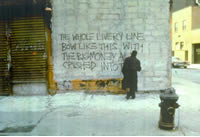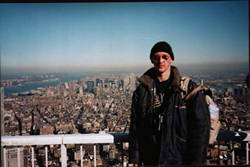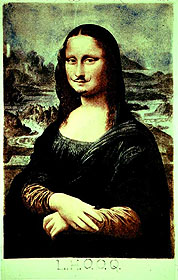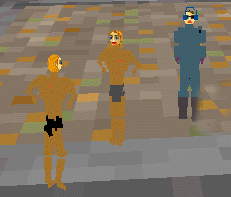| Author
|
Topic: - Resurrect
obscure memes that have faded into oblivion - |
liquidocean
Moderator
Sex/Love/Relationships
|
 posted 27 February 2002 22:42 (ip)
( posted 27 February 2002 22:42 (ip)
( ) )


 

|
|

'Soy Bomb' - 1998 Grammy Awards
"This much is certain: well into Dylan's performance of
"Love Sick," a man with the words "Soy Bomb" painted on his
bare torso appeared from behind the singer and then began a
flailing, jerky dance next to Dylan. The legendary performer
paid the uninvited dancer little mind as he writhed next to
Dylan for what seemed to be forever until he was hustled away
by security.
Beyond that, the story is as bewildering as the dance
itself. On Thursday, the "New York Post" identified the man as
26-year-old Michael Portnoy, a self-described "multigenere
mastermind artist" who also told the paper that he is "almost
a vegetarian."
Portnoy told the "Post" that he was on stage as one of the
young people recruited by the Grammys to sway and bop
approvingly in the background during Dylan's performance, and
that he cooked up his impromptu dance number as "an act of
pure revolution."
Asked about the meaning of his cryptic "Soy Bomb" message,
Portnoy told the "Post" that it refers to "sort of life and
death and explosion."
According to the "New York Daily News," Portnoy said his
true message was about commercialism's intrusion into the
world of art, and that somehow, "All art should be soy bombs."
The "Daily News" report also counters the "Post" report
that Portnoy was invited to the Grammys. The "News" reports
that the man (who despite his best efforts to shock the world
didn't even wind up being the evening's top story thanks to
Ol' Dirty Bastard) paid $200 to attend the ceremony.
Portnoy also told the "Daily News," "Bob Dylan is the past,
and I'm the future of music."
Maybe not, but Portnoy has secured a spot in music history
as a curious footnote."
[ 15 January 2003: Message edited by: liquidocean
] | |
|
|
|
|
liquidocean
Moderator
Sex/Love/Relationships
|
 posted 22 March 2002 22:17 (ip)
( posted 22 March 2002 22:17 (ip)
( ) )


 

|
|

link 1, link 2 - "Toynbee Idea in Movie 2001 —
Resurrect Dead On Planet Jupiter"
You might be
standing on an interplanetary message By John Stoehr
Will the dead rise on Jupiter? Could we stop them
if we tried?
Weird things are happening at major intersections in
downtown Cincinnati -- unnoticed by police or passers-by until
it's too late.
Someone is planting bizarre messages on tiles embedded in
the road surface. What the tiles are made of, who is placing
them and how they get away with it -- all of these questions
remain unanswered. What is known is this: We are not alone.
The mysterious tiles have been spotted in roads throughout the
Western Hemisphere.
If you go to Fifth and Walnut streets or Sixth and Walnut
streets, you will see, flush with the pavement in
multi-colored stenciling, two tiles that declare, "Toynbee
Idea in Movie 2001. Resurrect Dead on Planet Jupiter." A third
tile, at Main and Fourth streets, says, "Toynbee Idea in
Kubrick's 2001. Resurrect Dead in Planet Jupiter."
What do English historian Arnold Toynbee and filmmaker
Stanley Kubrick, creator of Dr. Strangelove and 2001: A Space
Odyssey, have to do with resurrecting the dead on planet
Jupiter? Who is behind this conundrum stuck in the macadam?
And is it something from which a strong mayor can save us?
'Some weird, strange saying'
The red, white and blue
Toynbee Tiles have appeared in Philadelphia, New York City,
Baltimore and Washington D.C., each city having at least 25
embedded in intersections within their municipal boundaries.
It doesn't stop there. Similar tiles have been spotted in
Cleveland, Boston, Pittsburgh, Atlantic City, Indianapolis,
Atlanta and as far south as Rio De Janeiro, Brazil, and
Santiago, Chile.
The tiles often include equally puzzling footnotes. One in
Newark, N.J. commands the reader, "Submit. Obey." In
Cleveland, one states, "Thanks. Goodbye." In New York, you'll
find: "Murder every journalist, I beg you." The tile at Sixth
and Walnut in Cincinnati has a footnote that's barely
discernable: "You Must Make + Glue Tiles!! You!! As Media
U.S.S.R."
Inevitably, the Internet is abuzz with speculation about
the Toynbee Tiles -- their clandestine installation, their
material substance, their global proliferation, the connection
between Toynbee and Kubrick. Many seem interested, but no one
knows with any certainty what they are.
Cincinnati officials are as clueless as everyone else.
Dennis Maddock, downtown street inspector, has seen the tiles
and even photographed them but is still scratching his head.
Maddock surmised the tiles began popping up over a year ago
but confessed to knowing very little else.
"I've seen them," Maddock said. "They say different weird
things. I have no idea what they are."
Sgt. Emmett Gladden of the Safety Director's Office is
baffled. Shown photos of the tiles, Gladden said, "That was
the first time I'd ever seen one."
Sgt. David Turner, supervisor of police intelligence,
wasn't much help in interpreting the hidden meaning of the
tiles, but he said police are not worried.
"I saw the signs," Turner said. "I have no idea what they
mean. As far as we're concerned, there's no meaning for us, so
we're not going to do anything about them."
Do the signs pose any public hazard or threat? "No," Turner
said. "People write all kinds of things out there -- graffiti
and that kind of thing. A lot of it's personal meaning, but we
don't think it was any kind of threat. We'd look at it if
there was an outright threat, but it's just some weird,
strange saying."
Dave Berens, one of the city's civil engineering
technicians, was equally in the dark.
"We have no idea who put them there or how long they have
been there," Berens stated in an e-mail message. Later he
elaborated over the phone.
"I went down there and looked at them," Berens said. "I
asked around and no one seemed to know anything about them. I
talked to one of our engineers for the downtown area. He
originally thought that they were something the Performing
Arts Center had done."
Dave Rupe, supervisor of engineering, summed it up for many
observers. "I don't know what you're talking about," he said.
Mayor Charlie Luken, a Democrat facing reelection, is
playing the issue of the Toynbee Tiles straight down the
middle. Asked, for example, if he thinks resurrecting the dead
on Jupiter is a good idea, Luken declined to be interviewed.
City Councilman Pat DeWine, however, had some thoughts.
"I don't know much about your tiles," DeWine said. "My only
thought is that I'm just happy someone is paving the streets
around here."
Where does DeWine, a Republican, stand on the issue of
raising the dead on Jupiter?
"Uh, well, it depends on the options," he said.
Councilman Jim Tarbell, a Charterite, was more
straightforward.
"I think resurrecting the dead on planet Jupiter is an
excellent idea," Tarbell said. "Considering everything else
we're dealing with, why not? This is a welcome relief from
what else is going on. We've developed 40 percent of the land
mass in Warren County in the last 10 years. What's that tell
you? We're running out of room. We can't do this anymore: The
dead have got to be buried on Jupiter at the very least."
'You don't want to find the answer'
I first discovered
one of these tiles when I moved to Cincinnati in 1998. Working
in the Schmidt Building, I crossed Sixth and Walnut every day.
At the time, I didn't think much of the tile, dismissing it as
nothing more than typical street graffiti. It never occurred
to me that the tile could be, as one Scientologist recently
put it, "some graffiti from Mars."
A year later, I was researching Toynbee's writings when I
came across a Web site devoted entirely to collecting and
cataloging the whereabouts and condition of Toynbee Tiles
around the world. Journalists in Washington, D.C., and
Baltimore have investigated the enigmatic phenomena, but none
has brought any light to the mystery. Rob Hiaasen, staff
writer for The Baltimore Sun, was so frustrated he asked in
print that anyone, anywhere, contact him with information
about the tiles. But no one, to this date, has claimed
responsibility.
Bill O'Neill has had a passion for the Toynbee Tiles ever
since he was an undergraduate at Temple University in
Philadelphia. In 1992, he built a Web site titled "What Is
It?" The site catalogues information about the tiles. He soon
learned he was hardly the only person obsessing about them.
"Before I knew it, other people who had done Internet
searches for the kind of stuff that's on the signs found my
site," O'Neill says. "They started sending me more submissions
and the site grew from there."
O'Neill has received thousands of e-mail messages and
pictures of the tiles. Many are simple notifications of a
sighting. But once in a while O'Neill received information
that could lead somewhere. The closest he got to solving the
mystery was an anonymous e-mail about a tile in Chile with a
Philadelphia address.
But O'Neill was unable to gird his loins enough to start
knocking on doors.
"I was always afraid to go ahead and check it out," he
said, "because it's one of those things where you've been
searching so long, you don't want to find the answer. Some
people have said they'd written the address and hadn't gotten
a response back."
The address on the Chilean tile is legitimate. After making
a few phone calls to the Philadelphia Recorder of Deeds
Office, I learned the name of the property owner, Verna
Severino, but was unable to contact her or the person living
at the address.
So far O'Neill, who now lives in Atlanta, has had little
luck unearthing key elements to solving the Toynbee Tile
mystery.
"For as long as I've been doing this," he said, "no one has
ever claimed to have done or know who has done it."
But O'Neill was closer than he thought. One of the e-mail
messages he received in 1999 had a 1983 newspaper article
titled "Theories: Wanna Run That By Me Again?" by Philadelphia
Inquirer staff writer Clark DeLeon. The article mentions a man
named James Morasco who'd been trying to contact media outlets
around the city about his theories.
Morasco was reportedly a social worker who believed we
could colonize Jupiter "by bringing all the people on Earth
who had ever died back to life and then changing Jupiter's
atmosphere to allow them to live." Morasco discovered these
ideas while reading the works of Arnold Toynbee. He also
believed Toynbee's ideas of resurrecting dead people's
molecules were depicted in Stanley Kubrick's monumental film
of regeneration and growth, 2001: A Space Odyssey.
In the Philadelphia telephone directory, only one James
Morasco is listed in the entire city. I called his number, and
an elderly woman answered the phone.
May I talk to Mr. Morasco? "He can't talk," the woman said.
"He has problems with his throat." What kind of problems? "He
had his voice box removed," she said. I see. How did he get
sick?
"We don't know," she said. It's something of a
mystery? "Right," she said.
A 'tantalizing detail' Perhaps you are beginning to grasp
the seriousness of it all. The only James Morasco listed in
Philadelphia has been silenced -- right there in the City of
Brotherly Love.
Another message O'Neill received in 1999 was from Nathan J.
Mehl, who claimed to have met a man in Philadelphia embroiled
in the idea of raising the dead on Earth and transporting them
to Jupiter. He posted wheat-pasted hand bills, with a message
similar to the tiles, at bus stops around Philadelphia,
according to Mehl.
Mehl, who was 17 years old at the time, forgot the man's
name. "I do remember one tantalizing detail, though," Mehl
wrote. "He made repeated reference to performing short-wave
radio broadcasts on a regular basis."
Apparently acclaimed playwright David Mamet heard such a
broadcast. In his 1985 collection of short plays and
monologues, Goldberg Street, Mamet wrote a three-page skit,
titled "4 A.M.," in which a radio talk show host talks to a
man obsessing over Toynbee, 2001 and dead people.
Of course, those familiar with 2001 know Kubrick adapted
Arthur C. Clarke's short story, "The Sentinel," to create his
masterful film. What most don't know is Clarke was a
contemporary of Toynbee and shared with the historian
philosophies infused with Christian tenets of birth, life,
death and resurrection.
Or something like that. What does it all mean? We might
never know.
Here's what we do know: Someone has somehow been able to
embed at least three tiles in the asphalt of major
intersections downtown, all of which convey a cryptic message
about resurrecting the dead on Jupiter, a phenomenon putting
Cincinnati on some kind of psychic plane with cities around
the world. And our mayor has nothing to say about it.
[ 23 March 2002: Message edited by: liquidocean
] | |
liquidocean
Moderator
Sex/Love/Relationships
|
 posted 22 March 2002 22:27 (ip)
( posted 22 March 2002 22:27 (ip)
( ) )


 

|
|

Negativland vs. U2, Island Records,
Casey Kasem, U.S.
copyright law
And yet, it is Kasem's signature
the band needs now to recover the rights and remaining,
confiscated copies of U2. After years of correspondence, they
finally got Island Records and U2's manager to agree to return
the rights to their work, but only if Kasem promises not to
sue anyone but Negativland later on. It was Island Records
that effectively squashed the album.
Who knew that making fun of U2 was gonna cause so much
trouble.
"Our goal is to protect the consumer," said
Island's Bill Adler, explaining the restraining order that
pulled U2 off the racks in September of '91. "The artwork is
deceptive. It's made to look as if it were a new U2 record. We
didn't want fans of the group buying this and being tricked."
Though Negativland's label at the time, former Black Flag
guitarist Greg Ginn's SST Records, did release the CD and
12-inch single just before U2's Achtung Baby arrived in
stores, and while the jacket art did make it look like a U2
record, the track itself could in no way be mistaken for U2;
hell, it mangled U2. Moreover, their "trick" was meant to
rattle the very kind of humdrum consumer who might mistake, on
first pass, a parody from the "real" thing, to make them aware
of how they are sold rock brands (as opposed to bands), and by
people who, as the man said, don't give a shit.
That
Island fancied itself an advocate for comatose shoppers was
only the first of many ironies in the case, and the brouhaha
that surrounded it is now legendary. Ginn, doing business as
SST (under the banner, "Corporate Rock Still Sucks"), caved in
to Island almost immediately and the disagreeable settlement
blew up later, when Negativland, having left SST, made the
entire affair highly public with a 97-page magazine (later
expanded into the 270-page Fair Use: The Story of the Letter U
and Numeral 2). Pissed off over the magazine (and other
things), Ginn sued Negativland and Negativland counter-sued,
taking advantage, finally, of pro bono (if not exactly pro
Bono) attorneys. Ginn and Negativland eventually reached a
settlement. The tragedy of U2/Negativland, Hosler told
California Lawyer magazine last year, "was that in 1991 we
didn't understand that we had an ideal case to defend."
Hosler's conviction stems from Negativland's exhaustive
study of the Copyright Act, drafted originally to prevent
plagiarism, not censor satire. (The prospects for Fair Use
have improved thanks to the unanimous 1994 Supreme Court
decision that defended 2 Live Crew's appropriation of Roy
Orbison's "Oh, Pretty Woman.")
"It's inevitable Pepsi
will find out, but we hope Pepsi has a sense of humor,"
Negativland member Don Joyce says. "Our intention is not to
get sued."
"We have never been in favor of bootlegs,"
clarifies Joyce. "Bootlegging is thievery and it's the
opposite of what we do. With a bootleg you try to make it
sound indistinguishable from the original. We try to transform
it, to make something new out of something pre-existing."
To be sure, not all of the U2 drama was bleak. Negativland
did its best to turn the whole thing into a Warholian
performance piece and Kasem and U2 were often up to it. Kasem
sent the group a copy of Norman Vincent Peale's The Power of
Positive Thinking. Mondo 2000's R.U. Sirius invited Hosler and
Joyce to surprise U2's guitarist, The Edge, during a phone
interview for the magazine. Toward the end of the
conversation, Hosler asked The Edge for a $20,000 loan to pay
the damages sought by Island. The Edge laughed and said he'd
think about it.
Throughout the ordeal, in fact, the members of U2 were for
the most part good-natured about the prank, although the band
never did make a B-side out of it, as U2 manager Paul
McGuinness once suggested, nor did The Edge wire any cash. A
comment on U2's friendly nonresponse can be found in Fair Use:
a photo of Bono singing, captioned with a U2 lyric, "I must be
an acrobat ... to talk like this, and act like that."
Yet another good thing to come out of the fracas was
Sonic Outlaws, an inspirational documentary film about media
pranksters by Craig Baldwin.
NEGATIVLAND, WITH OR WITHOUT U2
Still, while most of the press on the U2 single was
sympathetic, it tended to overlook the rest of Negativland's
career, thereby ignoring the sum of (as of now) 18 years of
experimental sound, sound fashioned from layered sampling long
before it reached mass audiences with hip- hop and Beck. Also
missed by most reports was Negativland's earlier, national
media hoax (chronicled on their CD Helter Stupid); their
unassailable DIY ethic (the band self-produces and has
hand-made the jacket art for each of the 15,000 copies of
their first record); and, perhaps most significantly, their
relentless critique of advertising, a critique that has become
so shrewd, the ad agency Wieden & Kennedy (of Nike fame),
has approached Negativland about doing some work for them on
the Miller Genuine Draft campaign. "We thought about it for 15
seconds," says Hosler, but then said no.
[ 15 January 2003: Message edited by: liquidocean
] | |
liquidocean
Moderator
Sex/Love/Relationships
|
 posted 23 March 2002 00:26 (ip)
( posted 23 March 2002 00:26 (ip)
( ) )


 

|
|

Basquiat - Samo
Jean-Michel Basquiat was born in Brooklyn, New York, in
1960. His father, Gerard, was an accountant. And like many
American boys, Jean-Michel drew cartoons and avidly read MAD
Magazine. These details seem quite plain. So what made
Basquiat’s life so unusual and his artwork so highly esteemed?
For starters, Basquiat was a black artist within an almost
exclusively white art world. However, blackness did not make
Basquiat famous; his work commanded attention on its own. In
fact, even his graffiti stood out from the countless scrawls
on the streets of Manhattan, evident when The Village Voice
offered a $100 reward for information to help identify the man
behind the tag, "SAMO." Exactly what made Basquiat one of the
most revered artists of the twentieth century is hard to
pinpoint. While some argue that he was a true genius, others
would retort that Basquiat merely got lucky as a product of
the times. But it is hard to believe that he owed everything
to luck.
Although Basquiat did not receive classical training in
art, in many ways his life indicates that he was a natural
artist. Basquiat’s mother, Matilde, introduced him to art at
an early age. She took him to New York’s museums and theaters,
and he learned to draw from the books she bought him, such as
Gray’s Anatomy. Basquiat had trouble tolerating those who were
less intelligent than he was (most notably his teachers), and
he never graduated from high school. For a while, he attended
"City-As-School" (CAS), a program designed to use the city’s
vast array of cultural assets (museums, planetariums, etc.) to
teach smart kids who had struggled at traditional schools.
As a student in the CAS program, Basquiat gave birth to an
idea that led to his first taste of fame. One night in 1978,
after smoking pot with friend Al Diaz in the CAS student
lounge, Jean-Michel came up with the idea of "SAMO." Standing
for "same old shit," SAMO represented a conceptual religion
that you could buy in packets, like a drug. Basquiat, Diaz,
and other friends made up all sorts of details for SAMO (such
as a weekly ceremony in which a Samoid priest placed yarn on a
person’s closed eyes, thus literally "pulling the wool over
your eyes"), and they began creating SAMO propaganda. They
drew cartoons and wrote essays about SAMO for the CAS student
paper, though the most important aspect of SAMO was the
propagandistic graffiti.
Basquiat and Diaz took ink markers and spray paint to cover
the streets with their SAMO graffiti. They wrote somewhat
cryptic and poetic sentence fragments all over lower
Manhattan’s art districts, signing each tag, "SAMO©." The
graffiti caught people’s attention. On December 11, 1978, The
Village Voice printed an article on SAMO and offered the $100
reward described above. However, SAMO merely represented a
starting point in Basquiat’s artistic career. When Basquiat
and Diaz had a falling out, Basquiat marked the end of their
collaboration by writing, "SAMO© IS DEAD."
After the initial attention surrounding SAMO, Basquiat
publicly exhibited his work for the first time in 1980 at the
"The Times Square Show." There, Jean-Michel created a large
installation piece and signed it "SAMO." Of the many artists
featured in the show, Basquiat was one of the few individuals
mentioned in the Art in America review, which noted: "A patch
of wall by SAMO, the omnipresent graffiti sloganeer, was a
knock-out combination of de Kooning and subway spray-paint
scribbles."
[ 15 January 2003: Message edited by: liquidocean
] | |
|
|
|
|
|
|
liquidocean
Moderator
Sex/Love/Relationships
|
 posted 24 March 2002 10:20 (ip)
( posted 24 March 2002 10:20 (ip)
( ) )


 

|
|

"Kilroy Was Here"
This meme originated during the second world war, when
wharf inspector James. J. Kilroy of Quincey, Massachusetts
used the slogan "Kilroy was here" to mark products he had
tested and approved. The marked products appeared on many
battlefields, and the signature that seemed to appear just
about everywhere caught the imagination of many soldiers, who
began to copy it on just about any writable surface (Funk
1950). Most likely others were intrigued by the slogan that
appeared in unlikely places, so they copied it further to
spread the myth.
While the meme spread well for several decades, it
eventually went all but extinct in its active form. There
seems to be several reasons for this:
Competition from other forms of graffiti, with stronger
ties to subcultures.
The ageing of the most highly infected population. Since
the tendency to scrawl graffiti is highly age-dependent, it
seems to be likely that as the original cohort aged, they did
not reproduce the meme as often as before, and the original
context was gradually lost.
A lack of novelty. Practically all people have been exposed
to the meme, but part of its appeal was the surprise effect of
a well placed "Kilroy was here" scrawl; once it has been seen
and understood enough, the novelty wears off. A bit
paradoxally, the meta-meme of knowing about the Kilroy meme
inhibits the further spread of the Kilroy meme, which makes it
in fact a contra-meme to the Kilroy meme. This is why today,
such a large body of people have knowledge about the meme,
i.e. the meta-memetical level, without actually being infected
by the original meme (otherwise it would still appear on the
city walls).
Properties of the Meme
"Kilroy was here" is extremely
well suited for the transmission phase, where it is encoded in
a graffiti vector. It is very easy to reproduce, and due to
its brevity the copying fidelity can be very high. Its
decodability is also high, since after the second world war
English became a lingua franca over a large part of the world
and acquired a certain status. The meme was spread by
English-speaking hosts, and would thus tend to end up in areas
where English was understood at least by a part of the
population.
The survival of graffiti is highly variable, but by its
nature it is semi-permanent and intended to be highly visible,
which ensures that more potential hosts notices it.
It is uncertain how well "Kilroy was here" can be
abstracted. In its original form, the graffiti vector was an
integral part of the meme and crucial to hint at that it
should be reproduced. Later variants appeared, such as a
cartoon figure and stickers, but they do not appear to have
been as fertile, mostly because they were harder to copy.
The meme's intimate connection to its vector, e.g. walls,
made it poorly fit to survive in other media. Also, the meme
was very sensitive for mutations. It was enough that you
changed one of its smallest parts, a letter, to seriously
damage the meme.
It is of great help to understand this phrase, that is to
know what the English words mean together. The problem of
decoding the sentence is quite an easy one, but it is harder
to decode what it really means. This is probably one of its
strengths. One can find ones own explanation of its meaning.
Further more it is small and simple. During a time when the
meme is popular, the host also gets multiple chances to try to
decode it.
Since the meme is without obvious meaning it is hard to
contradict, so there should be no active defence against the
meme. The meaninglessness of it can also invoke wandering
thoughts about the meme, and actively elaborating is connected
with better remembering.
What motivated people to spread the "Kilroy was here" meme?
There was never any direct host-to-host contact in the case of
this meme. This meant that no host received a direct positive
feedback, which is a powerful reproduction booster. And there
was no obvious hook accompanying the meme.
This is one of the great meme mysteries. Perhaps that was
enough motivation to spread the meme, to become part of the
mystery - and also, in the beginning, to share the joke of who
this much-talked-about Kilroy character was. Thus, the host
created a bond with a community of Kilroy writers, most of
which she would never meet, but could still belong to. A
feeling of belonging may have served as a hook to motivate the
conscious spread of the meme.
The Kilroy writers only way of confirming that there were
others was the indirect feedback, but this is also the point.
The Kilroy writers became invisible, even before each other,
so that the meme seemed to live its own life mysteriously
reproducing on the walls and the writers themselves could feel
as privileged members of a mysterious brotherhood.
[ 15 January 2003: Message edited by: liquidocean
] | |
liquidocean
Moderator
Sex/Love/Relationships
|
 posted 24 March 2002 10:33 (ip)
( posted 24 March 2002 10:33 (ip)
( ) )


 

|
|

Bert / Bin Laden
Right now, the two appear to be inseparable -- at least
on ubiquitous posters carried by pro-Taliban demonstrators.
Devotees of freak-humor websites will recall the infamous
"Bert is Evil" page, a shrine to the gourd-like Sesame Street
character, which offers compelling photographic evidence of
the muppet consorting with Hitler, the KKK and, of course,
Jerry Springer.
Now, in a move that defies all rules of logic, a doctored
photo showing Bert with the world's most-wanted terrorist,
Osama bin Laden, seems to have made its way into an
anti-American Islamic protest in Bangladesh.
Reuters photographs of a rally this week organized by
Jaamiat-e-Talabaye Arabia, a radical Islamic organization,
show that protesters created a pro-bin Laden sign out of a
collage of photos they apparently lifted from Internet sites.

But -- is it fate or coincidence? -- the sign featured a
Bert muppet sitting on the left side of the man believed to be
responsible for the bloodiest terrorist attack in U.S.
history.
An editor at Reuters' photo desk in Washington confirmed
that the maize-colored muppet did appear in the photograph.
"It is in the original image, though I couldn't say how it got
there. It wasn't hacked," the editor said.
One of the first sightings of the Osama-Bert poster was in
a news photo on a Netherlands portal site. Enterprising
Net-researchers soon reported it appeared in Sweden's leading
tabloid, and also on Yahoo's news photos section.
The "Bert is Evil" webmaster replied by writing this on his
website: "Yesterday a lot of you alerted me to a picture of a
Taliban propaganda poster with Bert! Reality is imitating the
Web! I am honestly freaked out! Holy shit!"
In an e-mail message to Wired News, webmaster Dino Ignacio
said: "My theory is that the Taliban have Internet too. And I
think Bert is universal enough to appeal to them, too."
A closer scrutiny of one of the photos reveals a second
apparent faux pas on the part of the radical Islamic
protesters: Another clip art photo of bin Laden used in the
photograph seems to show him with a bottle of Jack Daniels.
It didn't take long for word to spread. A discussion on
lindqvist.com is titled: "The mystery of the Bert-bin Laden
connection evolves with more images coming in every day. Is
this a big hoax? Has somebody got too much time? Or is
somebody in Bangladesh trying to confuse the world?"
Bert is best known for his role on the long-lived Sesame
Street children's show, where he lives with his housemate
Ernie.
[ 15 January 2003: Message edited by: liquidocean
] | |
liquidocean
Moderator
Sex/Love/Relationships
|
 posted 24 March 2002 10:45 (ip)
( posted 24 March 2002 10:45 (ip)
( ) )


 

|
|

The Tourist of Death
The identity of the world-famous "Tourist Guy" has been
revealed, but his fear of becoming an Internet freak show
means he'll be shunning the limelight. The Tourist Guy, or
"Tourist of Death," is a 25-year-old Hungarian man called
Peter. He asked that his last name be kept confidential,
because he doesn't want to become the next Mahir Cagri, the
lovesick Turk.
"I'd like to keep my identity incognito," he said in an
e-mail. "This was a joke meant for my friends, not such a wide
audience."
The break in Peter's silence ends two months of
rampant speculation over the identity of the man in a black
cap and eyeglasses who has become the latest Web craze.
Shortly after Sept. 11, Peter pasted a plane into a photo
of himself taken on the observation deck of the World Trade
Center on Nov. 28, 1997. Amused, he e-mailed it to a few
friends for a laugh.
The doctored photograph spread worldwide on the Net. Then
his face started cropping up all over the place. Web surfers
quickly turned Peter into the Forrest Gump of the Internet,
placing him at the scene of major, minor and just plain inane
events in history.
Websites dedicated to the meme, like Tourist Guy, Tourist
of Death and WTC Tourist, began collecting the pictures and
have been adding to their galleries daily.
Though well aware of his growing fame, Peter laid low for
weeks. He feared the mockery visited on previous Web celebs.
He didn't want to become an international laughing stock like
Mahir Cagri, or Clair Swire, the British woman whose
lascivious e-mail spread around the world like a virus.
"I was afraid that some people might have misunderstood my
intentions," Peter wrote.
But when Jose Roberto Penteado, a Brazilian businessman,
claimed to be the Tourist Guy, Peter's friends outed him to
the Hungarian online news site, Index.
Penteado scored a lot of media coverage at home and abroad,
as well as an offer to appear in a television commercial for
Volkswagen. But now it's clear he is not the guy.
Despite a close resemblance to the Tourist Guy, Penteado
was always at a loss to explain how his face was put atop the
doomed tower. He looked like the guy but the photographs
weren't his. He said he wasn't sure, but friends must have
digitally added his face to the photograph, as well as the
plane.
After seeing Peter's pictures, Penteado conceded that his
short-lived fame had come to an end.
"Now I believe that the real person showed up," he wrote in
an e-mail. "I think I have a brother in Hungary and I didn't
know."
It turns out Volkswagen had already withdrawn its offer to
put Penteado on TV. The company decided that being associated
with the destruction of the WTC wasn't the image it was
looking for, Penteado said.
The Brazilian actually welcomed his return to anonymity.
"Thank you all, and now I think I will have some peace and
quiet. I hope," he wrote.
Unlike his Brazilian rival, Peter has the original,
unaltered photograph of himself on the observation deck, or so
he claims. He scanned and e-mailed what appears to be an
undoctored copy of the original WTC picture to Wired News.
Prompted for more proof, Peter made a trip to his parent's
house to dig up additional photos of himself taken atop the
WTC, included above.
Wired News has not seen the original prints, but taken
together, the three pictures strongly indicate Peter as the
source of the original image.
Peter told Index the WTC pictures were taken during a trip
to New York to visit relatives. At the time, he was working at
a hotel in Colorado Springs, Colorado.
Despite his reluctance to embrace fame, the spotlight
beckons. Asked if he would consider a TV advert like the one
Penteado was offered, Peter was enticed. "Commercial?" he
wrote. "Maybe. Can that be done anonymously?"
His unexpected notoriety has already brought some
dividends. Old friends who recognized him from the picture
called him out of the blue.
"The good aspect of it was that some people I haven't seen
for a while looked me up," he wrote.
[ 27 September 2002: Message edited by: liquidocean
] | |
|
|
vect0rx
Moderator
Health Q&A
|
 posted 28 March 2002 03:05 (ip)
( posted 28 March 2002 03:05 (ip)
( ) )


 

|
|
Here's a
wierd one...

__________ "ate my balls",
where __________ is: Chewbacca, Mr. T, Batman, He-Man,
Seven of Nine, Kramer, The Original Yoda, Richard Simmons,
etc, etc ad nausium.
This meme never became mainstream as far as I can tell, but
I ran into it on the web many years ago, probably in 1996 or
1997, and found today that it is still going strong.
Try a google search for "ate my balls".
vect0rx
[ 28 March 2002: Message edited by: vect0rx
] | |
|
|
liquidocean
Moderator
Sex/Love/Relationships
|
 posted 12 May 2002 20:13 (ip)
( posted 12 May 2002 20:13 (ip)
( ) )


 

|
|
Thanks,
Dags!

Dada, Dadaism, Marcel Duchamp [French, from dada,
child's word for a horse]
Nihilistic movement in the arts that flourished chiefly
in France, Switzerland, and Germany from about 1916 to about
1920 [and later -ed.] and that was based on the principles of
deliberate irrationality, anarchy, and cynicism and the
rejection of laws of beauty and social organization.
The most widely accepted account of the movement's naming
concerns a meeting held in 1916 at Hugo Ball's Cabaret (Café)
Voltaire in Zürich, during which a paper knife inserted into a
French-German dictionary pointed to the word dada; this word
was seized upon by the group as appropriate for their
anti-aesthetic creations and protest activities, which were
engendered by disgust for bourgeois values and despair over
World War I.
In the United States the movement was centered
in New York at Alfred Stieglitz's gallery, "291," and at the
studio of the Walter Arensbergs. Dada-like activities, arising
independently but paralleling those in Zürich, were engaged in
by such chiefly visual artists as Man Ray and Francis Picabia.
Both through their art and through such publications as The
Blind Man, Rongwrong, and New York Dada, the artists attempted
to demolish current aesthetic standards. Traveling between the
United States and Europe, Picabia became a link between the
Dada groups in New York City, Zürich, and Paris; his Dada
periodical, 291, was published in Barcelona, New York City,
Zürich, and Paris from 1917 through 1924.
In 1917 the Dada movement was transmitted to Berlin, where
it took on a more political character. The Berlin artists,
too, issued Dada publications: Club Dada, Der Dada, Jedermann
sein eigner Fussball ("Everyman His Own Football"), and Dada
Almanach.
In Paris Dada took on a literary emphasis under one of its
founders, the poet Tristan Tzara. Most notable among Dada
pamphlets and reviews was Littérature (published 1919-24),
which contained writings by André Breton, Louis Aragon,
Philippe Soupault, and Paul Éluard. After 1922, however, Dada
faded and many Dadaists grew interested in surrealism.
[ 15 January 2003: Message edited by: liquidocean
] | |
liquidocean
Moderator
Sex/Love/Relationships
|
 posted 12 May 2002 20:19 (ip)
( posted 12 May 2002 20:19 (ip)
( ) )


 

|
|

In the spring of 1964, Ken Kesey invested nearly all his
writing royalties and created a company known as Intrepid
Trips, Inc., which funded the adventures of the Merry
Pranksters -- essentially a group of hippies determined to
live and explore life to the fullest, in the Here and Now. To
the establishment, the Pranksters were the epitome of the
stereotype of the era, the Drug-Crazed Freak.
Kesey's first novel, One Flew Over the Cuckoo's Nest,
(about an insane asylum that revealed the madness of society
itself) and his then just-completed second novel, Sometimes A
Great Notion (about the logging business) had both received
critical acclaim, and both eventually wound up on the silver
screen. Kesey, at age 28, was being heralded as one the great
writers of the day.
With Intrepid Trips established, Kesey bought an old bus, a
1939 International Harvester school bus to be exact, fully
equipped with bunks, a refrigerator, cabinets and sink, the
perfect road vehicle. With Babbs and numerous other Pranksters
-- including Neal Cassady (Speed Limit,) Kesey's brother
Chuck, Carolyn Adams (Mountain Girl,) Page Browning, George
Walker, Sandy Lehmann-Haupt, and Mike Hagen (Mal Function)--
Kesey painted every last inch of the old school bus in
blasting psychedelic day-glo patterns, swirling colors, images
and mandalas. The Pranksters rigged it with a sound system so
they could broadcast outside as well as inside of the bus, and
cut a hole in the roof so anyone who felt like it could sit up
there and play music or trip on the bird's eye view of the
ride.
Finally, they fashioned a destination sign and placed it on
the front of the bus: 'Furthur' it read.
They balanced it with one on the back that read: 'Weird
Load'
When the bus was finally Prankster approved, they mixed up
a huge batch of orange juice. Not just any orange juice. But
orange juice spiked with LSD. Since LSD would not be outlawed
until 1966, this was the one drug on board that was perfectly
legal.
On a warm summer day, the Weird Load took off bound for New
York. There, they would take in the World's Fair and celebrate
the publication of Kesey's second book.
The plan was to film the journey along the way. It was
supposed to be the first acid movie, a veritable breakthrough
in artistic expression. It was, in fact, the original magical
mystery tour. Beyond the acid, the Pranksters were equipped
with costumes --overalls, T-shirts, jeans, most all accented
in screeching green and halting orange day-glo. Babbs,
especially, was seriously into day-glo, and used it to paint
virtually everything, including his face.
The Prankstersí now-famous journey, chronicled in Tom
Wolfe's American classic, The Electric Kool-Aid Acid Test
included endless encounters with straight America. For
instance, Kesey was invited to speak at a Unitarian Church
Conference for youth, influencing quite a number before the
talk was done. The Pranksters partied with the Hell's Angels;
tripped through the Beatles performance at the Cow Palace; and
virtually blew away Timothy Leary and his cast of LSD voyagers
with their wild and crazy approach to life. As strange as
Leary may have been to the average American bear, Kesey and
the Pranksters were viewed by the Leary crew as downright --
weird.
Kesey rose to prominence in the psychedelic scene, and was
hailed as 'The Chief' among those who followed his lead. The
Merry Pranksters took their philosophy of living NOW public
with staged Acid Tests -- public happenings where people could
explore the far reaches of consciousness and achieve altered
states through readily available psychedelics, primarily LSD.
In fact, just about everything truly Sixties -- from the
swirling day-glo or blacklight, radiantly colorful pop art and
op art to the Grateful Dead's acid rock sound to campus
rebellion against the establishment -- was seeded by the Merry
Pranksters. | |
Catch-22
Administrator
|
 posted 19 May 2002 22:10 (ip)
( posted 19 May 2002 22:10 (ip)
( ) )


 

|
|

The unknown protester who brought an entire line
of tanks to a halt
The lone Chinese protester who brought a column of tanks
to a standstill in Tiananmen Square during the 1989 crackdown
was never arrested and is still at large, a Hong Kong-based
dissident group has said.
Seven hundren people were killed in the Tiananmen Square
crackdown Chinese students who supported the pro-democracy
movement captured the attention of the world's media with
their seven-week occupation of Tiananmen Square in June
[1989].
However, the most memorable images are of a young man,
carrying what appears to be a shopping bag, who refused to
move out of the way of the advancing tanks.
He then climbed onto the leading tank and spoke to the
driver.
The Information Centre for Human Rights and Democracy
Movement in China says it has obtained official documents that
show the Chinese government does not know what happened to
him.
Although the man was initially identified as Wang Weilin,
the documents suggest the name was false.
In response to an inquiry, President Jiang Zemin is said to
have blamed journalists for giving authorities the wrong name.
The Chinese government gave up looking for the man after
checking lists of the dead and imprisoned.
Time magazine has cited the unidentified protester as one
of the "top 20 leaders and revolutionaries" of the 20th
century.
Dubbing him "the Unknown Rebel," the American news journal
said his moment of fame was seen by more people than laid eyes
on Winston Churchill, Albert Einstein and James Joyce
combined.
Chinese authorities sent tanks into Tiananmen Square in the
early hours of June 4, 1989 to break up an extended
demonstration by Chinese student activists. Several hundred
people were reported to have been killed.
China has never admitted publicly that there were any
deaths as a result of the crackdown.
Source: BBC
[ 19 May 2002: Message edited by: Catch-22
] | |
|
|
liquidocean
Moderator
Sex/Love/Relationships
|
 posted 27 September 2002 08:38 (ip)
( posted 27 September 2002 08:38 (ip)
( ) )


 

|
|

'Fish Wars' - (click on picture for link)
For some time now, we've all seen cars with little metal
fish screwed into the rear end where the model and
dealership's name sometimes are. Most people know that the
fish is a symbol of Jesus Christ, whose name is often spelled
out in Greek inside the fish. It's a way of spreading the
evangelistic Christian meme complex.
Evangelism is an essential component of a virus of the
mind. If a religion does not evangelize -- contain as part of
its teaching that it is important to "save," "convert," or
"pass the favor on" -- then it is at a severe disadvantage
when competing with other belief systems for a share of
people's minds. The fish on the back of the car is but a small
means of taking the message into the age of advertising.
Televangelists have done a much more effective job at the same
thing, consistently increasing their "market share" at a time
when most religions see their membership ("memebership"?)
dwindling.
More recently, there's been a new fish in the sea of cars:
a little fish with legs growing out of its bottom. Inscribed
inside the fish, in place of the Greek "Jesus," is the word
"Darwin."
I laughed the first time I saw this, but then started to
think. Have scientific-minded folk finally figured out what is
one of the main points in my book "Virus of the Mind": that
it's evangelize or be evangelized, meme or be memed? Did this
Darwinian fish disseminate from the Simonyi Chair at Oxford
held by Richard Dawkins, his mission to popularize science by
peppering it with good memes? If not, it's the kind of thing
that should be done.
Most people's experience of science is a boring high-school
class with impenetrable textbooks and difficult exams. If
scientific ideas could be as fun as astrology, and be as good
ice-breakers at parties, we'd be on our way. I myself have
begun to ask "what's your blood type?" instead of "what's your
sign?" and launch into an informal research project along the
lines of Dr. Peter D'Adano's ideas about diet and blood type.
Meanwhile, though, the fish wars continue. Last seen was an
escalation on the Christian side: A big Jesus fish, mouth
gaping, about to swallow the little Darwin fish. Heh heh. But
it's sad that religion vs. science has to be seen as a
competition. The purpose of religion is to guide us in living
meaningful, fulfilling lives. Science should compliment that,
not compete with it. Much of the fuss is about conflicts
between scientific theories of the past and religious creation
myths. These are not the most important things to be thinking
about anyway. What kind of future do we want to create? How
will we accomplish it? When I meet in San Francisco next month
with many other concerned individuals from around the globe at
the State of the World Forum, we will address these issues.
They are big, almost imponderable issues, but thinking about
them is a step in the right direction.
[ 27 September 2002: Message edited by: liquidocean
] | |
|
|
vocab
Bluelighter
|
 posted 27 September 2002 17:44 (ip)
( posted 27 September 2002 17:44 (ip)
( ) )


 

|
|
Rigging
Software to Swear
by Niall McKay
1:10 p.m. Oct. 9,
1998 PDT
To protest what he called the threat to family
life posed by technology, a disgruntled programmer claims he
sabotaged an educational software package to teach kids to
swear.
"No program can replace the family, but people have
this awe of technology, they think it can do better than they
can," the programmer, who spoke on condition of anonymity.
The Secret Writer's Society, a Macintosh game published by
Panasonic Interactive Media, is designed to help 7- to
9-year-olds learn to write by reciting their compositions back
to them.
But the simple game goes awry when a child types three or
four sentences in a row and double clicks the mouse. At that
point, the program will recite words such as "masturbation,"
"fellatio," "asshole," and other words that make many parents
squeamish.
The anonymous programmer, who added the features to the
game while under contract to Panasonic, developed the crack
with the help of RTMark, a venture capital-style funding
organization for activists.
"I wanted to wake parents up to reality -- here's what
happens if you hand your responsibility to some machine," the
programmer said in the RTMark statement, which will be
released on Monday.
RTMark paid the coder US$1,000 for his trouble.
When the problem first emerged in June, Panasonic blamed a
software glitch and offered replacement copies to any
concerned parents. On Friday, the company again denied that
the swearing software was the product of sabotage.
"We wrote that software in-house, so I believe that the
programmer's claims are untrue," said Panasonic's Elizabeth
Olson.
Olson said that the problem resulted from a feature written
by Makoto Morise, head of the company's education and DVD
division.
"We were aware that kids could use the software to read
back bad language so Makoto wrote some code prohibiting the
software from reciting about 40 swear words," said Olson.
But the editor of a Web magazine that evaluates educational
software finds the rogue-programmer explanation plausible.
Andrew Maisel, the editor in chief of SuperKids, said he found
it strange that the problem only hits Macintosh computers.
"I don't believe that Panasonic developed the
text-to-speech software in-house, and so I would suspect that
[the] so-called bug could indeed [be] the action of a rogue
programmer."
Panasonic claims that kids will have a hard time getting
Secret Writer's Society to utter obscenities. But Maisel
disputed that claim, saying that colorful language was only a
few clicks away for a curious child.
Last year, RTMark offered similar assistance to a
programmer at Maxis, the software publisher behind SimCopter.
In that incident, a staff programmer added unscripted
characters to the game that only appeared in certain scenes.
The unauthorized male SimCopter characters wore bathing
suits and kissed each other with loud smooching sounds. In
that incident, the programmer was fired and the game was
recalled.
Screen shot of the Sim Copter hack:

| |
vocab
Bluelighter
|
 posted 27 September 2002 18:03 (ip)
( posted 27 September 2002 18:03 (ip)
( ) )


 

|
|
THE BLO --
BARBIE LIBERATION ORGANIZATION -- STRIKES
By BRIGITTE
GREENBERG
Associated Press Writer
SAN DIEGO (AP)
When 7-year-old Zachariah Zelin ripped
off the Christmas wrapping, he
squealed with delight. Santa
brought the talking G.I. Joe doll he wanted.
Problem was,
Joe talked like Barbie.
His doll stands at the ready in its Army fatigues, machine
gun and hand
grenades at its side. But it says things like,
"Want to go shopping?"
The BLO has claimed responsibility. That's Barbie
Liberation Organization.
Made up of more than 50 concerned parents, feminists and
other activists,
the BLO claims to have surreptitiously
switched the voice boxes on 300 G.I. Joe
and Barbie dolls
across the United States this holiday season.
"We have operatives all over the country," said one BLO
member, who wished
to remain anonymous. "Our goal is to
reveal and correct the problem of gender-
based
stereotyping in children's toys."
Among the messages the tampered G.I. Joe utters are, "I
love school. Don't
you?" and "Let's sing with the band
tonight."
In a deep voice, the altered Barbie says, among other
things, "Dead men tell no
lies."
The BLO claims a few other doll voices were reversed in
Canada, France and
England. The group contends Barbie
teaches sexism and passivity in girls, and
G.I. Joe
influences boys to act violently.
A spokesman for Hasbro Inc., the maker of G.I. Joe, called
the BLO's attack
"ridiculous."
"This will move us to have a good laugh and go on making
more G.I. Joes," said
Wayne Charness of the Pawtucket,
R.I.-based toymaker. "Barbie dolls and G.I.
Joes are part
of American culture."
A spokeswoman for Barbie's creator, Mattel Inc. of El
Segundo, would say only
that no consumers have complained.
When Zachariah was asked whether he wanted Santa to take
back the feminine Joe,
he responded sharply, "No way."
"I love him. I like everything about him," he said as he
and three neighborhood
friends played with the doll. "He's
teaching me not to fight."
His parents are thrilled, too. Although Zachariah has water
guns, his parents
say they oppose violent toys and were
unwilling to buy the G.I. Joe.
The doll was Zachariah's grandparents' idea. The parents
were shocked, but
tickled, when the doll turned out the way
it did.
Zachariah's parents said they are not part of the BLO, and
had never heard of it.
"I think it really became an educational toy. I'm really
happy it worked out
this way," said Zachariah's mother,
Susan Orlofsky. "Our job is to help him
understand so that
he doesn't think he has to be a soldier. I think it's
amazing."
http://users.lmi.net/~eve/download/barbiedir.pdf
[ 27 September 2002: Message edited by: vocab
] | |
liquidocean
Moderator
Sex/Love/Relationships
|
 posted 27 September 2002 22:30 (ip)
( posted 27 September 2002 22:30 (ip)
( ) )


 

|
|
good ones,
guys
In 1986, Dan Rather was chased, pummeled and kicked on a
Manhattan sidewalk by a well-dressed man who kept asking
"Kenneth, what is the frequency?"
That quixotic statement, and Rather's account of the
surrounding circumstances, baffled the world. Some doubted the
CBS anchor's story altogether. The line took on a life of its
own, spawning a hit song, a slang term and the punchline to
Letterman jokes for the rest of the decade.
Now, it seems the "Kenneth" mystery has been solved--and we
all owe Dan an apology. His assailant turned out to be William
Tager, 49, who's serving a 25-year prison sentence for killing
an NBC stagehand outside the Today show studio. Tager told a
psychiatrist that he thought the news media was beaming
signals into his head. One of his obsessions apparently was to
find out the frequency of the signals.
Yesterday, after examining photos given to him by the New
York Daily News, Rather finally fingered Tager. "Everybody's
had their guess about what happened, and some have had fun
with it. Now the facts are out. My biggest regret is he wasn't
caught before he killed somebody," Rather told the newspaper.
While it remains unclear why the attacker addressed Rather
by the wrong moniker, the legacy of the Kenneth query remains
firmly entrenched in pop culture. "Kenneth" has entered
Gen-X-speak, meaning a confused or just plain clueless person.
And, most famously, R.E.M. borrowed the line for "What's
the Frequency, Kenneth?" on 1994's Monster album. The track
turned out to be prophetic, with lyrics like: "'What's the
frequency, Kenneth?' is your Benzedrine/I was brain-dead,
locked out, numb, not up to speed."
In a moment of self-parody, Rather donned shades and joined
the band at Madison Square Garden for a tuneless (on Rather's
part) rendition of the song, which aired on the Late Show with
David Letterman.
[ 27 September 2002: Message edited by: liquidocean
] | |
liquidocean
Moderator
Sex/Love/Relationships
|
 posted 22 October 2002 10:39 (ip)
( posted 22 October 2002 10:39 (ip)
( ) )


 

|
|

Guardian Angels began twenty years ago, on February 13,
1979. In the years prior to the Guardian Angels launch, Curtis
Sliwa had become famous for his neighborhood clean-up and
beautification projects in the South Bronx. Using his
co-workers at the Fordham Road McDonalds, where he was the
night manager, Curtis formed the "Rock Brigade." The Rock
Brigade received accolades and a full wall of awards from
community and governmental groups around the city. Planting
and cleaning up vacant lots, boarding up bombed-out buildings,
they managed to make this notorious inner-city neighborhood
more beautiful. But it wasn't any safer, nothwithstanding how
well-swept the sidewalks were.
The elderly sought refuge in the MdDonalds, knowing that
Curtis would walk them home safely, along with his coworkers.
When one retired transit worker pleaded with Curtis to do
something about the muggers and street thugs, Curtis decided
to expand his neighbohood cleanup and pride program - to
patrol the subway, then known as the "Muggers Express."
He recriuted a multi-racial team of volunteers, largely
gleaned from his employees at the McDonalds. It started out
with Curtis and twelve volunteers. They were known intially as
the "Magnificent Thirteen." They agreed to ride the subways
between the toughest stops, without weapons, to find the gang
members who had been mugging the straphangers in the subway
and detain them for the police to arrest.
It was a dark time in New York, with massive budget
deficits, law enforcement layoffs and increasing crime. There
was no funding for much needed law enforcement either from
within or from without New York. Neighborhood watch groups
were desperately needed, but they were not universally
welcomed.
Notwithstanding some initial resistance, the thirteen soon
grew to thousands, and was renamed the Guardian Angels, to
counter the then-popular Hell's Angels group: Angels for good
as a contrast to the Hell's Angels, who had glamorized
violence and terror. With men and women from around the world
forming the Guardian Angels chapters world-wide, they made a
difference in the lives of people in the communities they
patrolled, every single day.
As the streets have become safer, the Guardian Angels have
devoted more time to safety education and inner-city children
programs. Local chapters use their hard-earned experience to
teach self-defense courses and "street smart" skills to
seniors, women and community groups, schools and university
students around the country.
| | |